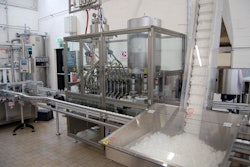1. Serialization will gain ground
While FDA hasn’t yet confirmed the rules on track-and-trace for pharmaceuticals, the smart money will follow California’s lead and get a head start with serialization. Food and beverage manufacturers staring down the new food safety regulations and looking to get a jump on farm-to-fork will get in the act. Nutraceuticals and nutritionals may be the bridge between the two worlds.
2. Condition monitoring will add value
More packaging machine builders will pick up on control systems’ growing ability to monitor operating conditions -- things like energy consumption, temperature, integrated safety and vibration – by way of inexpensive, off-the-shelf modules. But packagers, take note. You will need to add these functions to your specifications if you want them to become widely available.
3. Accelerating software convergence in packaging
Packagers and their suppliers need to look at packaging machine and line controls holistically, and the next big thing will be convergence of the business performance applications on the same processor as the machine control. There will be a Windows side of the control – not a separate HMI or PC -- displaying OEE data, running interactive help when the controls indicate a fault and doing vision system calculations while the real-time side optimizes throughput. These apps will have a cumulative, positive impact on packaging line performance.
4. Brazil will be on your radar
Whether a CPG or a machinery supplier, if you’re a multinational, Brazil was one of your top destinations in 2011. And while some observers saw the Brazilian manufacturing economy stumble this past year, Brazil will only increase in importance as its economy continues to develop. Will you attend Fispal 2012?
5. Retail ready…or not, here it comes
So far, the European trend to retail ready packaging has largely been translated in the U.S. to corrugated case and tray packing configurations. For clues to the next retail ready wave, visit Canada, where they’ve always been more connected to the Continent. Expect to see more wraparound and two-piece display formats on retailers’ shelves, including primary-pack quality printed paperboard cartons.
6. Safety first…and next
Will North American machine builders get another reprieve from conforming to the EN ISO 13849-1 machinery safety standard? As of this writing, it doesn’t look like the 2009 two-year extension to EN 954-1 will be renewed. This will be an important topic that PMMI will help its member companies address in 2012. But it may be better to bite the bullet now, as the new standard supports the next generation mechatronics designs that our machinery industry will need to compete against.
7. Plant seeds now to win big later
The problem with annual predictions is the time it takes for profound change to take root. You just can’t tell how it’s going to play out five years from now unless you’ve been there, been the early adopter before. And don’t expect your competitors to telegraph their strategies. If you want to plant some of your own seeds this year, watch where companies like Nestlé, P&G and Pfizer are leading the OMAC Packaging Workgroup. Come to the ARC Forum in Orlando February 7-9 if you want a front row seat.
8. Advanced technologies for turnkey systems
You’ll also begin to see multi-touch widescreen HD displays for SCADA systems, more integration of design and simulation tools with control software development, and failsafe CPU redundancy going mainstream. Look for these technologies to show up in the larger, turnkey processing and packaging lines first.
9. Better interaction with operators on individual machines
On stand-alone machines, look for HMI screens to get bigger, wider, easier to navigate, integrating more Windows applications, with more videos to guide operators and techs through changeovers and maintenance procedures. The animations I predicted will still come along with wider use of 3-D modeling tools, it’s just that production is still costly. (Someone needs to take me up on Purdue University Calumet’s offer to put its students on your HMI animation project).
10. NA and EU OEMs consolidate
It’s been happening without fanfare. But North American machine builders are buying European OEMs to gain technology and market access. And European OEMs are doing the same over here. Another approach is for OEMs from two continents to represent or private label each other’s equipment. This has been going on a long time, no revelation about that. But anticipate a steady increase in this activity as (1) weakness in the European market forces inventive ways to boost exports, while (2) North American OEMs need to simultaneously protect domestic market share and grow their own exports with minimal risk.


























